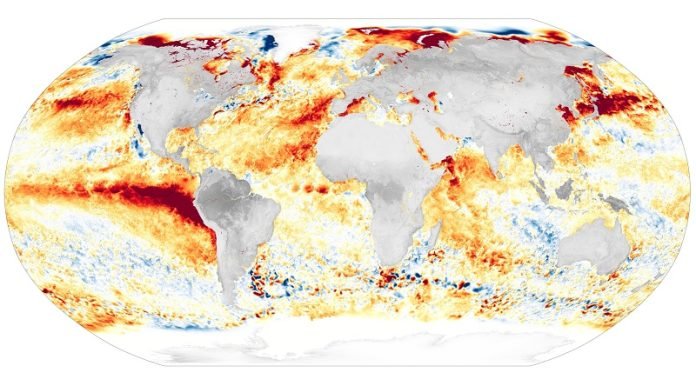
In 2023, the world’s oceans are hotter than ever recorded, especially the Pacific Ocean.
For four months in a row, the surface water of the oceans was nearly 1 degree Celsius (1.78 degrees Fahrenheit) warmer than what is considered normal.
So why is this happening?
Scientists from NASA think they know the answer: a climate event called El Niño and long-term global warming.
Josh Willis, an ocean expert at NASA, said that El Niño, a climate pattern that heats up the Pacific Ocean, is making the ocean even warmer on top of the global warming that has been happening for a century.
This means the warm ocean water is not just a one-time thing; it’s part of a larger pattern that we’ve been seeing for a long time.
Maps show that on August 21, 2023, the ocean was over 3 degrees Celsius (5.4 degrees Fahrenheit) warmer than normal in many places. That includes the Pacific Ocean near Japan and the USA’s California and Oregon.
The Indian, Southern, and Arctic Oceans were also unusually warm.
This data comes from a special project that blends measurements from different sources like satellites and ships. Gavin Schmidt, who heads NASA’s climate study institute, said this long-term warming is mostly because of human activity.
We have been releasing a lot of greenhouse gases into the atmosphere since factories and cars became common, and this is making the Earth, including the oceans, warmer.
Scientists have said that 90% of the extra heat caused by greenhouse gases ends up in the ocean. This year, the El Niño in the Pacific made things worse.
The heat jump in April lines up with when the Pacific started getting hot and the sea levels began to rise. What happens in the Pacific is super important because it’s so big—it makes up about half of the world’s ocean area.
Heatwaves in the ocean are not good news. In August, nearly half of the world’s oceans were experiencing what’s called a marine heat wave.
This can harm sea life and change weather patterns. These heatwaves can stick around for weeks and are driven by weather conditions.
However, the heat in the Pacific, due to El Niño, is expected to last even longer and possibly into winter.
NOAA forecasters think there’s a 95% chance that El Niño will stay around all winter, affecting global weather patterns and making oceans even warmer. Scientists are using tools like sensors and satellites to keep an eye on this because it could have big consequences for our climate and our lives.
So, the next time you hear about record heat, remember it’s not just about hot days on land. Our oceans are heating up too, and that’s something we need to pay attention to for the sake of the planet.
Follow us on Twitter for more articles about this topic.



